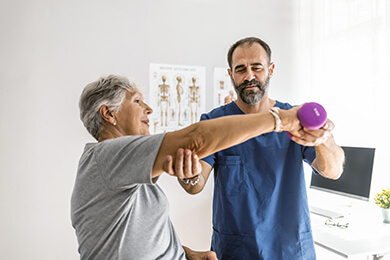In-home physical therapy or in-center?
Posted 11/18/2022 | 4 min. read
Why successful medical rehabilitation should have both
Bad knees, bad hips, bad back.
These are just a few common complaints that bring people to physical therapy (PT) in search of relief.
Feeling off balance?
Sprains and strains?
Pain in the neck?
More reasons why more than one million patients sought help through our outpatient physical therapy centers in 2021.
But the past two years, coming out of the pandemic, have brought a renewed focus to in-home care delivery throughout the industry, like physical therapy treatment.
While in-home physical therapy isn’t new – our centers have offered it since 2010 – some newer ways to receive it are growing in popularity.
Take virtual physical therapy, or telerehab, for example.
Its biggest benefit is convenience. Stay in your home and do sessions on your own from your computer or smartphone. If you’re technology savvy, a virtual care delivery model might be appealing.
Recovering from an illness or injury at home? Some level of in-home care delivery can be beneficial in getting you back on your feet again.
But so can in-person rehabilitation at a physical therapy center.
In-center you’ll have the benefit of one-on-one time with clinical specialists who can assess your movement and progress. If you’re new to physical therapy, this is an important consideration. You’ll need feedback to help you become aware of proper body movement, posture and form in doing exercises.
With decades in providing outpatient physical therapy, we look at each patient as an individual. Our treatment of them is also as an individual, which means the best treatment isn’t a this-or-that way; in-center or in-home.
It’s both, one after the other.
Curious about why?
Read on to learn more.
In-home physical therapy: where does it fit in treatment?
Many of our patients come to us for orthopedic rehabilitation. This is the side of physical therapy that treats musculoskeletal pain – bones, muscles, joints and tendons.
Injury and degeneration of the musculoskeletal system can lead to tremendous pain. At its worst it can mean lost function in these essential body parts.
Pain may also result from overuse or overexertion. Ask any of your weekend warrior friends who push the limit of their athletic exercise and end up with injuries.
Musculoskeletal joint-related pain, in particular, makes up a good portion of what we treat in our centers:
- Neck
- Shoulder
- Wrist
- Hand
- Low back
- Hip
- Knee
Aside from injury and overuse, joint pain can also be brought on by repetitive stressors, like typing, lifting, bending and other activities going long periods without interruption.
In most cases, we treat in-center using hands-on or manual therapy techniques and exercises tailored for your condition or injury.
But there’s an aspect of joint-related conditions where combining in-center and in-home physical therapy is a win-win: joint replacement surgery.
Surgery can reduce the severity of joint pain or get rid of it entirely.
But it’s not a magic bullet, as anyone who’s had a knee or hip replacement can tell you.
Surgery is disruptive to the body.
Post-surgery pain is real.
Also called post-operative pain, it can include inflammation of tissue at the incision site. The surgical site and surrounding ligaments – and the new joint – will need time to adapt to movement. This can be very uncomfortable.
Physical therapy rehabilitation post-surgery will help with reducing pain and discomfort, and regaining function.
Recovery in these early stages after surgery is effective at home, when led by a clinical therapist, in-person.
In the comfort of your home, therapy exercises will help you safely work through muscle and joint stiffness to get back to normal movement. At this point, we like to get patients back for in-person sessions at our centers to continue toward full recovery.
“We see positive outcomes if patients leave their house and come to an environment that provides social, hands-on interaction,” said Kelly Scott Kover, national director of clinical innovation at Select Medical. “Those are the patients we’ll have the best impact with – in a hybrid care model.”
About 8 in 10 patients in our physical therapy programs take part in therapy before and after joint replacement.
Why before?
Let’s take a look at that.
As effective as physical therapy is for rehabilitation after surgery, it’s also effective in preparing for surgery.
Called “prehab,” it’s becoming better known as part of joint replacement therapy.
Post-operative studies show it leads to better outcomes, including:
- fewer days in the hospital
- more stamina for physical exercise after discharge
- getting familiar with therapy equipment – before surgery – that will be used in your recovery
Of course, there are many other considerations where in-home physical therapy can be effective in rehabilitation.
You may be limited by travel, injury or a weakened immune system from cancer treatments. Our clinical experts will bring our services to you to help you heal in place and rebuild strength.
Both in-home and in-center options have benefits. Both may be considered when we put together your treatment plan in an initial evaluation. Combining the two may work well for you.
If you’re on the road to surgery, joint replacement or other, or need rehabilitative treatment for other reasons, fill out our online Request an appointment form. A member of our team will connect with you to confirm your visit.

